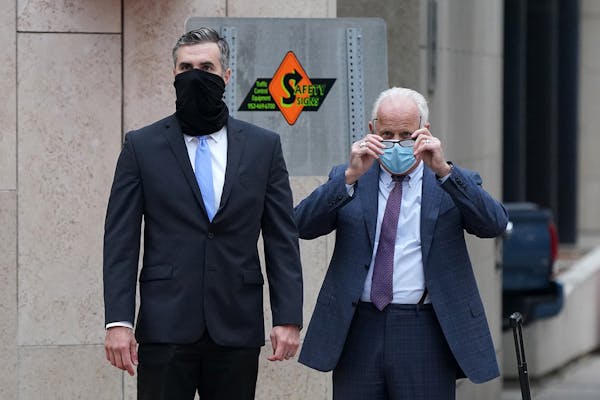Prosecutors' latest narrative of George Floyd's final moments reveal that Minneapolis police officer Derek Chauvin pinned George Floyd's neck to the ground for 9½ minutes, longer than previously cited, according to a court filing Tuesday.
The motion, in which Minnesota Attorney General Keith Ellison's team argues for the admissibility of key evidence, provides the most detailed account yet of Floyd's final moments as attributed to body camera footage from three of the officers that has since been made public.
It says the officers pinned Floyd to the asphalt for about 9 minutes, 30 seconds — longer than the 7 minutes, 46 seconds and 8 minutes, 46 seconds previously cited by prosecutors, the latter time stamp having been adopted by activists as a symbol for police brutality in protests following Floyd's May 25 death.
Both Floyd and those in a growing crowd pleaded for his life, but "for over four and a half of those minutes, Floyd was silent," according to the court document. "For at least three of those minutes, Floyd appeared not to be breathing. And for at least two and a half minutes, the officers were unable to locate Floyd's pulse.
"After Floyd fell silent, the crowd alerted the officers 10 times that Floyd was no longer moving, warned them nine times that Floyd was unresponsive, and pleaded with them nearly 30 times to check Floyd's pulse."
Four former officers are charged in relation to Floyd's death. Chauvin faces charges of second-degree unintentional murder, third-degree murder and second-degree manslaughter. J. Alexander Kueng and Thomas Lane — who helped hold Floyd down — and Tou Thao, who held back the crowd, are each charged with aiding and abetting murder and manslaughter. All four have been fired.
The court document depicted Lane as quick to draw his firearm and scream obscenities at Floyd, who was sitting in his car when he and Kueng arrived. In another instance as Floyd pleaded to breathe, Chauvin responded: "You're doing a lot of talking, a lot of yelling. It takes a heck of a lot of oxygen to say things."
The body camera video captured Kueng reacting to Chauvin's comments with a smirk, according to the filing.
Early in the encounter, after the officers handcuffed Floyd, Kueng brought Floyd to the curb and asked him to sit down. "Floyd did so, immediately becoming calmer and saying thank you to Kueng three times," according to the court document.
Later, Floyd appeared afraid to be in the car alone, repeatedly telling the officers he suffered claustrophobia. After Chauvin and Kueng pinned him against the back seat, Thao said they were "just going to have to hogtie him." Floyd shouted "I can't breathe" almost a dozen times after they pinned him to the ground, according to the motion.
A growing crowd shouted concerns that Floyd couldn't breathe and he "wasn't even resisting arrest."
"He's talking, so he's fine," said Thao. "This is why you don't do drugs, kids."
An off-duty Minneapolis firefighter introduced herself and asked to give Floyd medical assistance, and Chauvin, holding a can of Mace, warned her to stay away.
When Floyd passed out, Lane asked the others if they should roll him on his side in a recovery position, a suggestion he repeated as the crowd expressed concerns over Floyd being unresponsive. "Chauvin rejected that option out of hand, telling Lane and Kueng to 'stay put where you got him,' " according to the document.
"Just leave him," Kueng concurred.
Kueng finally complied with the crowd's pleas to check Floyd's pulse.
"I can't find one," Kueng reported. He tried again 10 seconds later, then leaned back and sighed. "I can't find one."
Still, the officers held him there — Chauvin pressing his knee into Floyd's neck, Lane and Kueng atop Floyd's legs and back, Thao on crowd control — for another two minutes and thirty seconds.
"The officers also ignored the off-duty firefighter's plea for them to begin chest compressions," says the motion. "Indeed, none of the officers ever attempted CPR while Floyd was on the ground."
When paramedics arrived, Lane told them Floyd wasn't responsive and they leaned to check his neck for a pulse. Chauvin still kept his knee pressed into Floyd's neck.
Floyd was pronounced dead later at the hospital. The Hennepin County medical examiner ruled Floyd died from "cardiopulmonary arrest complicating law enforcement subdual, restraint, and neck compression," listing the cause as "homicide." A separate medical examiner also listed "police subdual and restraint" as the cause of death.
Ellison's motion also argues for the admissibility of the officers' histories, saying their past shows a pattern of behavior, knowledge of their actions and that their use of force went beyond what was necessary.
Many of the accounts include Chauvin using force, sometimes while working security off-duty, on people who don't comply with his commands. In one case, Chauvin "delivered a few strikes" to a juvenile who was not cooperating, then "applied a neck restraint" and rolled him over to handcuff him. The juvenile was bleeding from the ear after the struggle and needed stitches.

Want to share info with the Star Tribune? How to do it securely

'Safe recovery sites' would offer syringes, naloxone and more to people using drugs. The plan could be in peril.
New Minnesota GOP leaders seek peace with party's anti-establishment wing

Who is Republican Lisa Demuth, Minnesota's first House speaker of color?

